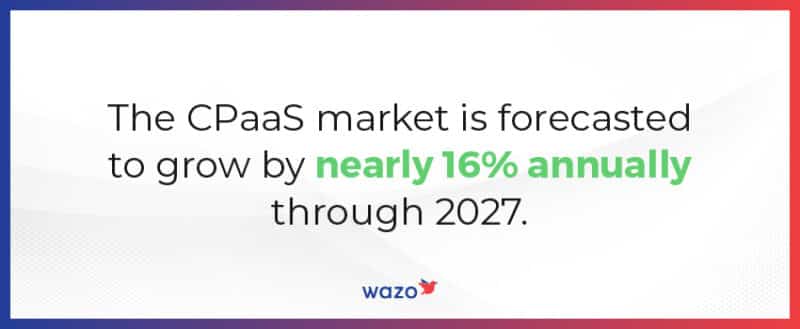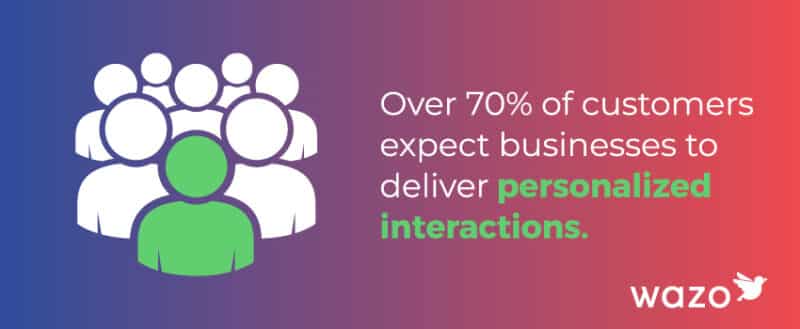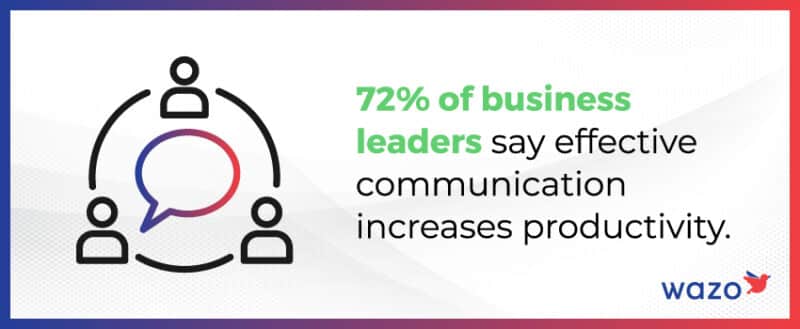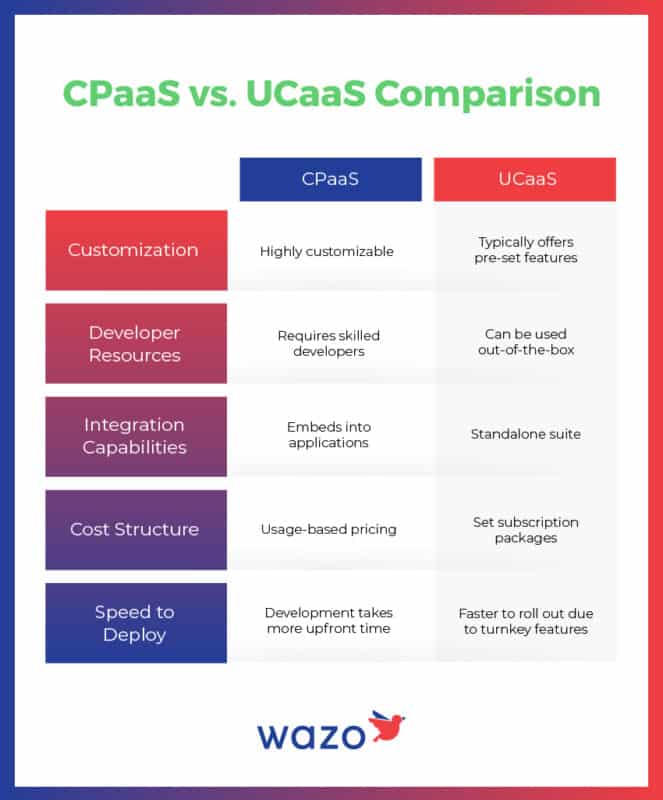Clear, consistent internal communications and customer communications across multiple channels are no longer a luxury – they’re baseline expectations for businesses of all sizes. However, with the rise of cloud-based communications, it can be challenging for service providers to determine if they can best meet their clients’ needs with unified communications as a service (UCaaS) or by building customized integrations on top of a communications platform as a service (CPaaS).
As of 2023, 30% of organizations have adopted UCaaS as their primary communications platform, with another 26% planning to make the switch.1 And with the CPaaS market forecasted to grow by nearly 16% annually through 2027,2 it’s clear that service providers need to understand the core differences between UCaaS and CPaaS to ensure they’re meeting their customers’ communication needs.
In this blog, we’ll explore the differences between UCaaS and CPaaS solutions to help you determine which platform is the best fit for your business communications offerings.
CPaaS vs. UCaaS: The Basics
UCaaS and CPaaS solutions share some similarities, but key differences set them apart. Both platforms provide cloud-based communication features without the need for on-premise hardware. However, their service delivery models differ significantly. Here’s how:
- UCaaS delivers a pre-built, unified suite of real-time communications features like telephony, video conferencing, messaging, and more.
- CPaaS offers APIs and SDKs that allow for integrating customized communication capabilities into existing applications and workflows.
Essentially, UCaaS provides an all-in-one communications solution, while CPaaS enables developers to build tailored communications features.
What Is CPaaS?
A communications platform as a service solution provides application programming interfaces (APIs) and software development kits (SDKs) that allow businesses to integrate real-time communication functionalities into their own software applications and workflows.
With CPaaS, developers can embed communications features like text messaging, voice calls, video chat, and more using pre-built code snippets instead of developing back-end infrastructure from scratch. CPaaS acts as a set of building blocks that cloud service providers can leverage to improve the communication capabilities of their software solutions.

CPaaS Benefits and Limitations
CPaaS platforms offer several benefits, including flexibility, scalability, and cost savings. However, CPaaS software also includes limitations that service providers should be aware of. Here’s a breakdown:
Benefits
- Flexibility and customization – CPaaS allows businesses to build fully customized communication tools aligned with their unique needs. APIs make it easy to embed only the required capabilities.
- Scalability – CPaaS technology is extremely scalable, with usage-based pricing that allows companies to pilot new integrations with minimal investment.
- Innovation – The flexibility of CPaaS APIs fosters innovation through easy expansion of communications features. Businesses can test creative new approaches to engage customers.
- Retain existing systems – Integrating CPaaS with current platforms means no rip-and-replace of legacy systems for fewer disruptions to operations.
Limitations
- Development expertise required – While CPaaS features simplify development, some coding knowledge is still required. Companies without technical teams may struggle to leverage CPaaS effectively.
- Time investment – Even with APIs, building custom integrations takes more upfront time versus an out-of-the-box UCaaS platform. However, the long-term benefits typically outweigh the initial costs.
- Complex coordination – Juggling multiple API relationships across various channels can prove complex, requiring tight integration management.
When Should Businesses Use CPaaS?
Certain business use cases are especially well-suited for CPaaS solutions, including:
Personalizing Customer Experiences
Over 70% of customers expect businesses to deliver personalized interactions – and 76% get frustrated when they don’t.3 CPaaS lets companies provide a tailored, branded customer experience across channels like voice, SMS, instant messaging, or video.
Enhancing Internal Apps and Workflows
Companies can use a CPaaS solution to integrate communications capabilities like notifications, alerts, and messaging directly into existing business applications employees use daily to streamline workflows without disruption.
Offering Omnichannel Flexibility
With CPaaS software, businesses can flexibly engage customers across their channels of choice and provide seamless transitions between channels to ensure customer service agents deliver consistent interactions.

What Is UCaaS?
Unified communications as a service solutions offer a pre-packaged suite of cloud communication and collaboration tools, including IP telephony, video conferencing, omnichannel capabilities, messaging, and more.
UCaaS provides an all-in-one platform to support communications instead of piecing together single-channel products and services. These solutions streamline internal communication and improve productivity by consolidating multiple communication channels into one user-friendly platform.
UCaaS Benefits and Limitations
UCaaS platforms offer benefits like better team collaboration, improved mobility, and simplified management. However, it also has limitations for service providers. Here’s a breakdown:
Benefits
- Simplicity – UCaaS eliminates the need to integrate disparate tools. Everything is in one place and works seamlessly together through unified management.
- Productivity – Synchronized capabilities ensure contextual collaboration. Click-to-call, screen pops, CRM integrations, and more streamline workflows.
- Reliability – Leading UCaaS providers deliver carrier-grade voice quality and uptime. Companies avoid maintenance of complex on-prem infrastructure.
- Scalability – Cloud delivery and usage-based pricing allow easy scaling to support business growth and seasonal fluctuations in demand.
Limitations
- Vendor dependence – Companies must choose features from the vendor’s roadmap versus building fully custom tools aligned with unique needs.
- Deployment disruption – Transitioning communications to a new UCaaS system creates temporary business disruption as employees adapt to an entirely new platform.
- Cost – UCaaS bundles multiple capabilities into expensive premium packages, forcing companies to pay for some unnecessary features.
When Should Businesses Use UCaaS?
The unified nature of UCaaS makes it a great fit for certain business needs, including:
Turnkey Communications Suite
UCaaS works well for companies that want to improve internal communications with a turnkey platform that includes integrated telephony, contact center, conferencing, and collaboration capabilities without major customization needs.
Internal Team Communication
72% of business leaders say effective communication increases productivity.4 UCaaS solutions help improve productivity by enabling end users to access all the communication tools they need to connect and collaborate in one platform.

Contact Center Foundation
UCaaS functionality like intelligent call routing, interactive voice response (IVR) menus, call recording, omnichannel queues, and customizable agent desktops provide an excellent customer service foundation.
Replacing Legacy Phone Systems
Transitioning from outdated on-premise phone systems to UCaaS allows businesses to modernize their communications infrastructure without having to install or maintain expensive, specialized hardware.
CPaaS vs. UCaaS: A Side-by-Side Comparison
While CPaaS and UCaaS solutions share many similarities, they differ in:
Customization
One of the biggest differences between CPaaS and UCaaS is the ability to customize the solution. CPaaS provides communications APIs and building blocks to create customized tools tailored to specific business needs. UCaaS generally delivers pre-configured bundles of communication features in a one-size-fits-all platform.
Developer Resources
Leveraging CPaaS platforms requires some development expertise to integrate APIs and build customized capabilities, making them a better fit for companies with in-house developers or dev partners. UCaaS can be used out-of-the-box without any coding or technical skills.
Integration Capabilities
CPaaS solutions integrate communication features directly into existing business applications through APIs, allowing dev teams to improve current workflows without major disruptions. UCaaS operates as a standalone suite separate from other software systems.
Cost Structure
CPaaS pricing models are based on usage, allowing businesses to start small and pay only for features used. UCaaS providers typically offer set monthly or annual subscription packages bundling multiple capabilities, some of which may be unnecessary for some customers.
Speed to Deploy
While CPaaS allows for highly customized integrations, developing these does require more upfront time investment compared to getting started quickly with ready-to-use UCaaS suites. UCaaS can typically be rolled out faster due to its turnkey nature.

Should Your Business Use CPaaS or UCaaS?
Determining if your business should sell CPaaS or UCaaS will depend on your specific needs and priorities. Some general guidelines to follow include:
CPaaS
A CPaaS platform is best if your customers:
- Require highly tailored communications aligned with unique needs.
- Have in-house developer resources or partner relationships.
- Want to expand on existing platforms vs. rip-and-replace.
- Prefer pay-as-you-go pricing for specific capabilities.
UCaaS
A UCaaS platform is best if your customers:
- Prefer a turnkey suite with minimal customization needs.
- Need consolidated communications management.
- Want the simplicity of an all-in-one communications platform.
- Are replacing legacy telephony systems.
UCaaS vs. CPaaS: Find the Right Fit With Wazo
As a managed service provider, understanding the core differences between CPaaS and UCaaS is critical when evaluating the right communications solution for your customers. Regardless of the type of platform you offer, focus on delivering robust solutions with carrier-grade reliability, future-proof scalability, and expert technical support. This provides the best value and experience for your customers while differentiating your offerings in a crowded market.
If you’re looking to stand out from competitors, consider partnering with Wazo to build unified communications solutions perfectly tailored to meet your customers’ needs. We make it easy for service providers to level up customer experiences through open, customizable APIs and integrations on top of our proven, scalable UCaaS platform. Ready to learn more about how Wazo can help you create a unique communications platform with a UCaaS platform built for MSPs? Book a demo today.
Sources:
- https://www.techtarget.com/searchunifiedcommunications/tip/How-to-evaluate-top-UCaaS-providers-and-vendors-of-2023
- https://blogs.idc.com/2023/06/05/momentum-is-building-in-the-cpaas-market
- https://www.shopify.com/enterprise/personalization-trends
- https://www.grammarly.com/business/business-communication-report

